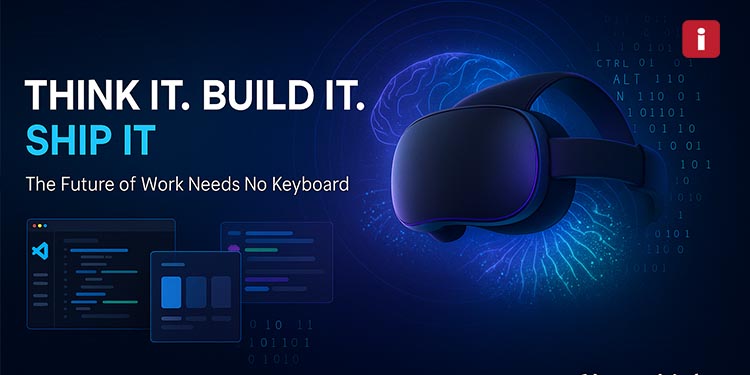The Future of Work Needs No Keyboard
Imagine a world where you can code, design, send emails, and create content simply by thinking. This is the bold promise of NeuroLink AI, a disruptive startup that entered the scene in May 2025 with a groundbreaking brain-computer interface (BCI) technology. With $200M in Series B funding and partnerships with some of the biggest names in tech, including Microsoft and Salesforce, NeuroLink AI is on a mission to radically transform how we interact with computers and they might just be onto something.
But is mind-controlled computing truly the future of work, or is it just another overhyped tech fantasy? Will we all be ditching our keyboards and typing with our thoughts by 2030?
The Origins of NeuroLink AI | Turning Sci-Fi into Reality
The Vision Behind the Innovation
NeuroLink AI was founded by Dr. Elena Rodriguez, a Stanford neuroscientist, and Mark Chen, a former Tesla AI engineer. Their shared frustration with the limitations of traditional human-computer interaction led to the idea for a brain-computer interface that would allow users to communicate with machines through their thoughts.
The journey from concept to reality wasn’t without its challenges. Early on, NeuroLink AI’s prototypes faced regulatory hurdles from the FDA and misinterpreted commands, such as turning “I need coffee” into a catastrophic “terminate process” command. Yet, after years of development and trial and error, the team succeeded in creating a non-invasive EEG headset that could read and interpret neural signals with a high degree of accuracy. This headset is now the core of NeuroLink AI’s breakthrough technology, providing a direct connection between the user’s brain and their devices.
“Why type at 60 WPM when your brain processes thoughts at lightning speed?”
— Mark Chen
How NeuroLink AI Works | Mind Over Mouse
Revolutionizing Productivity with Thought-Controlled Software
What sets NeuroLink AI apart from other brain-computer interface technologies like Neuralink is that it’s non-invasive. Instead of requiring surgical implants, NeuroLink AI uses a wearable EEG headset combined with powerful machine learning algorithms to translate brainwaves into digital commands. The system works by detecting and interpreting neural signals as you think, allowing you to control devices, software, and even create content without lifting a finger.
Key Features of NeuroLink AI’s Technology:
- Non-invasive: Unlike Neuralink, which uses surgical implants, NeuroLink AI’s headset simply needs to be worn like any other wearable device, with no need for surgery.
- Software integration: The headset seamlessly integrates with popular software tools like VS Code, Slack, Zoom, and Figma. Users can draft emails, manipulate 3D models, and even write code all just by thinking.
- Real-world demonstrations: During early demonstrations, users were able to use the system to complete real-world tasks such as writing and editing documents, designing graphics, and engaging in online meetings without touching a single key or screen.
“It’s like telepathy, but for productivity.”
— Early Beta Tester
NeuroLink AI’s technology could dramatically boost productivity, with some studies showing that developers are able to code twice as fast when using the BCI headset compared to traditional typing. Designers and engineers can now navigate complex 3D spaces and design workflows with ease, all through thought alone.
NeuroLink AI’s Impact on the Tech Industry
Why the Tech World Is Paying Attention
NeuroLink AI’s innovation isn’t just a cool idea—it’s supported by tangible results. In initial beta tests, users have demonstrated remarkable productivity improvements across industries. Some Microsoft engineers participating in the trials found themselves coding 2x faster when using the headset. Designers also report spending less time on repetitive tasks, instead working with intuitive mind-controlled interfaces that feel almost like an extension of their own thoughts.
It’s clear that NeuroLink AI is more than just a novel concept. It’s a game-changer for productivity. The company’s $200M Series B funding round caught the attention of major investors, including Microsoft, which has invested $50M into the startup. NeuroLink AI is already running pilot programs with Salesforce and other major enterprise clients, demonstrating real-world value in workplace productivity.
NeuroLink AI vs. Neuralink: What Sets Them Apart?
Although both NeuroLink AI and Neuralink work with brain-computer interfaces, the two technologies have distinct differences that cater to different needs and markets. Let’s break it down:
Feature | NeuroLink AI | Neuralink |
Invasiveness | Non-invasive (wearable headset) | Invasive (surgical implants) |
Primary Use | Enterprise productivity (work) | Medical and clinical trials |
Regulatory Status | FDA-cleared for work use | Still in clinical trials |
While Neuralink focuses on medical applications, such as helping people with neurological conditions, NeuroLink AI aims to enhance productivity and streamline workflows in corporate and creative industries. This makes NeuroLink AI the ideal candidate for workplace use, where employees need faster and more efficient ways of interacting with digital tools.
Addressing Skepticism: The Road Ahead
Concerns and Criticisms
As with any groundbreaking technology, NeuroLink AI faces its share of skepticism and criticism. Let’s explore some of the key concerns:
- Privacy: With mind-controlled computing comes the question of data security. What happens to the thoughts that the system collects? Who owns that data, and can it be kept secure?
- Learning curve: Some users find that it takes 1-2 weeks for the AI to fully adapt to their unique brain patterns. The question remains: How accessible will this technology be for the average person?
- Cost and accessibility: Given its cutting-edge nature, NeuroLink AI could initially be out of reach for most people. Will the digital divide prevent this technology from becoming mainstream, or will it be democratized over time?
Despite these concerns, NeuroLink AI is committed to addressing privacy issues and ensuring that the system remains user-friendly, transparent, and accessible to a wider audience as it grows.
The Future: What’s Next for NeuroLink AI?
The Roadmap to 2030 and Beyond
The potential of NeuroLink AI extends far beyond the workplace. By 2026, the company plans to release a consumer version that will enable people to control VR and gaming environments with their thoughts. Further into the future, NeuroLink AI envisions a world where everyday tech from smart homes to digital assistants—is fully integrated with mind-controlled interfaces.
Key goals for the company include:
- Expanding into VR and gaming markets.
- Forming collaborations with industry leaders like Apple and Google.
- Creating open-source platforms to foster greater transparency.
“We’re building a world where tech obeys intent, not fingers.”
— Dr. Elena Rodriguez
Will You Ditch Your Keyboard?
The future of thought-controlled computing could be just around the corner. Are we ready to ditch our keyboards in favor of mind-powered productivity? With NeuroLink AI leading the charge, the future of work is looking faster, quieter, and more intuitive than ever.
Get Involved with NeuroLink AI Today
The future of work is evolving—and NeuroLink AI is at the forefront. Whether you’re a tech professional, a creator, or a forward-thinking innovator, the possibilities are endless when we think beyond traditional interfaces. Join the movement and be part of the next evolution in computing.
- Stay Updated: Sign up for our newsletter to receive the latest updates on NeuroLink AI and upcoming product releases.
- Connect with Us: Follow us and keep up with developments and join the conversation.
NeuroLink AI is shaping a world where technology listens to your thoughts. Are you ready to shape the future with us?













































